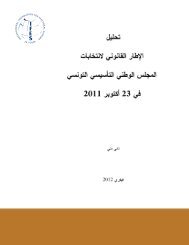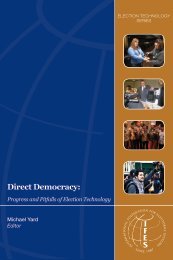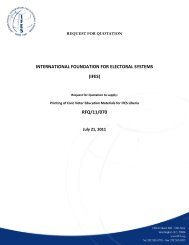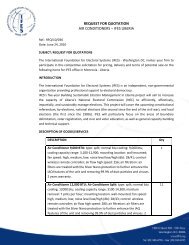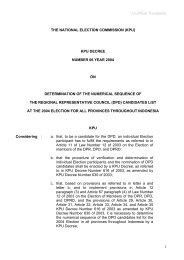Electronic Voting & Counting Technologies - IFES
Electronic Voting & Counting Technologies - IFES
Electronic Voting & Counting Technologies - IFES
- No tags were found...
Create successful ePaper yourself
Turn your PDF publications into a flip-book with our unique Google optimized e-Paper software.
INTRODUCTIONINTERNATIONAL ELECTORAL STANDARDSWhen an electronic voting and countingsolution is technically feasible, there still maybe grounds for deciding not to pursue it if theadvantages are minimal, the disadvantagesare significant, the risks are higher, the costsare far greater than the advantages or there issignificant stakeholder resistance to the newtechnology. The way in which these factorsare balanced will be entirely dependent on theparticular electoral environment. Countries orelection management bodies with significantresources may be willing to spend a lot moreto obtain an electronic voting and countingsolution for the same net benefits thancountries and election management bodieswith fewer resources.At the end of the day the decision will not bea purely administrative one, it may be political.The feasibility study will need to fully explorethese different components of the decision inprinciple so that all stakeholders are aware ofthe technical and financial aspects of possibleelectronic voting and counting technologiesadoption, the net benefits, and likelystakeholder reaction to the technologies.While a well executed decision in principlewill go a long way in ensuring that anyintroduction of electronic voting and countingtechnologies is done in a sound manner,there is only so much that can be understoodabout electronic voting and countingtechnologies without actually using them.Therefore, before any final decision can bemade about the possible use of electronicvoting and counting technologies it isessential that the technology be piloted.“Before any final decisioncan be made about thepossible use of electronicvoting and countingtechnologies it is essential thatthe technology be piloted.”Stage 2: Pilot Prerequisites — While theinclination may be to jump straight into a pilotproject, there are a number of prerequisitesand parameters that need to be establishedbefore conducting a pilot. Such prerequisitesand parameters include the establishmentof the pilot project mandate, passage oflegislation enabling the pilot, development ofrequirements and technical specifications forthe solution to be piloted and funding for theconduct of the pilot project. Once these arein place, the next stage of the process, thepilot project can start.Stage 3: Pilot Project — The purpose ofa pilot project is to demonstrate whetheran idea or concept is feasible in practice.In the context of an electronic voting andcounting feasibility study it should be used todetermine the following:• The solution(s) being piloted operates asexpected• The benefits anticipated can be achieved• The disadvantages entailed in using thetechnology are as anticipated and can bemitigated in an acceptable way• To assess and revise, if necessary, the listof requirements for any solution to meetthe needs of the electoral environment14<strong>Electronic</strong> <strong>Voting</strong> & <strong>Counting</strong> <strong>Technologies</strong>: A Guide to Conducting Feasibility Studies







